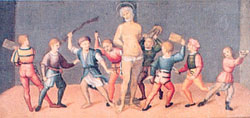
Feastday: August 13
Patron: of Imola, Mexico City, schoolteachers, shorthand-writers, parish clerks.
Death: 363
Martyr of Imola, near modern Ravenna, Italy. He was a teacher arrested for being a Christian. His students were invited to hack him to death when he refused to deny Christ. Prudentius recorded Cassian's grisly martyrdom, noting that the students could not wield mortal blows, thus prolonging the martyr's agony. His cult is confined to local calendars.
Cassian, or Saint Cassian of Imola, or Cassius was a Christian saint of the 4th century. His feast day is August 13.
Life
 Cassian being killed by his pupils. From the Dutch Martyrs Mirror.
Cassian being killed by his pupils. From the Dutch Martyrs Mirror.
Little is known about his life, although the traditional accounts converge on some of the details of his martyrdom. He was a schoolmaster at Imola, but rather than sacrifice to the Roman gods, as so ordered by the current emperor, Julian the Apostate, he was condemned to death and turned over to his own pupils. Since they were eager for revenge for the many punishments he had inflicted on them, they bound him to a stake and tortured him to death by stabbing him with their pointed iron styli, the devices then used to mark wooden or wax writing tablets. Cassian suffered in one of the persecutions of the third century, but in which cannot be assigned with any certainty.
He was interred by the Christians at Imola, where afterwards his relics were honoured with a rich mausolæum. His traditional date of martyrdom is August 13, 363, hence August 13 is his feast day on the Roman calendar. Cassian is the patron saint of Mexico City, Imola (Italy), Sukošan (Croatia), and of parish clerks. Comacchio Cathedral is dedicated to him. He is also the patron saint of the localities of San Casciano in Val di Pesa (Italy) and Las Galletas (Tenerife, Spain). St Cassian's Centre is named for him.
Cultural references
There are at least two references in modern literature to Cassian. In the novel A Confederacy of Dunces by John Kennedy Toole, protagonist Ignatius Reilly informs one of his professors that "St. Cassian of Imola was stabbed to death by his students with their styli," a holy death that his professor would not merit. Annie Dillard also makes a reference to him in her 1992 novel The Living. Bethel College had a Cassianus Lounge in the faculty offices area.
The famous German jurist Carl Schmitt, named the place in which he spent his late years (in Plettenberg) as "San Casciano". According to the common opinion (for the own Schmitt, the most obvious interpretation), this referred to some place near Florence, Italy (called San Casciano) in which Macchiavelli spent the time during which he wrote some of his most influential works. Schmitt acknowledges this view but addresses as "exoteric". On the other hand, the "esoteric" interpretation of the choice would be actually related to the very Saint Cassian of Imola. Carl Schmitt identified with the Catholic martyr insofar as he also felt as some sort of teacher assassinated or stabbed (i.e. betrayed) by his own students(e.g. by Otto Kirchheimer).





